Page 31 of 299
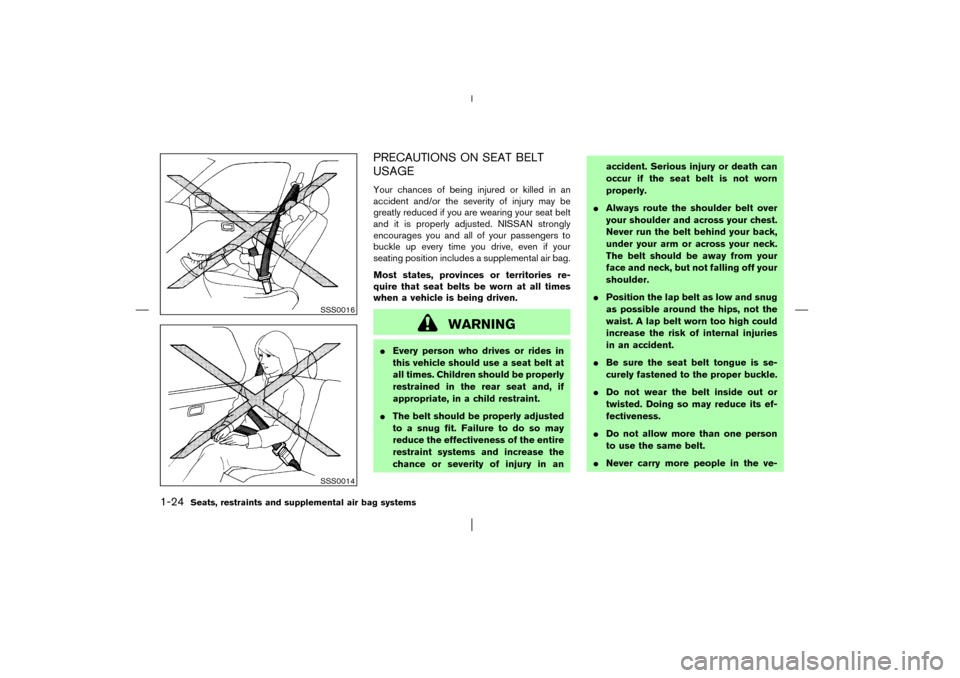
PRECAUTIONS ON SEAT BELT
USAGEYour chances of being injured or killed in an
accident and/or the severity of injury may be
greatly reduced if you are wearing your seat belt
and it is properly adjusted. NISSAN strongly
encourages you and all of your passengers to
buckle up every time you drive, even if your
seating position includes a supplemental air bag.
Most states, provinces or territories re-
quire that seat belts be worn at all times
when a vehicle is being driven.
WARNING
�Every person who drives or rides in
this vehicle should use a seat belt at
all times. Children should be properly
restrained in the rear seat and, if
appropriate, in a child restraint.
�The belt should be properly adjusted
to a snug fit. Failure to do so may
reduce the effectiveness of the entire
restraint systems and increase the
chance or severity of injury in anaccident. Serious injury or death can
occur if the seat belt is not worn
properly.
�Always route the shoulder belt over
your shoulder and across your chest.
Never run the belt behind your back,
under your arm or across your neck.
The belt should be away from your
face and neck, but not falling off your
shoulder.
�Position the lap belt as low and snug
as possible around the hips, not the
waist. A lap belt worn too high could
increase the risk of internal injuries
in an accident.
�Be sure the seat belt tongue is se-
curely fastened to the proper buckle.
�Do not wear the belt inside out or
twisted. Doing so may reduce its ef-
fectiveness.
�Do not allow more than one person
to use the same belt.
�Never carry more people in the ve-
SSS0016SSS0014
1-24
Seats, restraints and supplemental air bag systems
�
03.1.28/R50-D/V5
�
Page 32 of 299
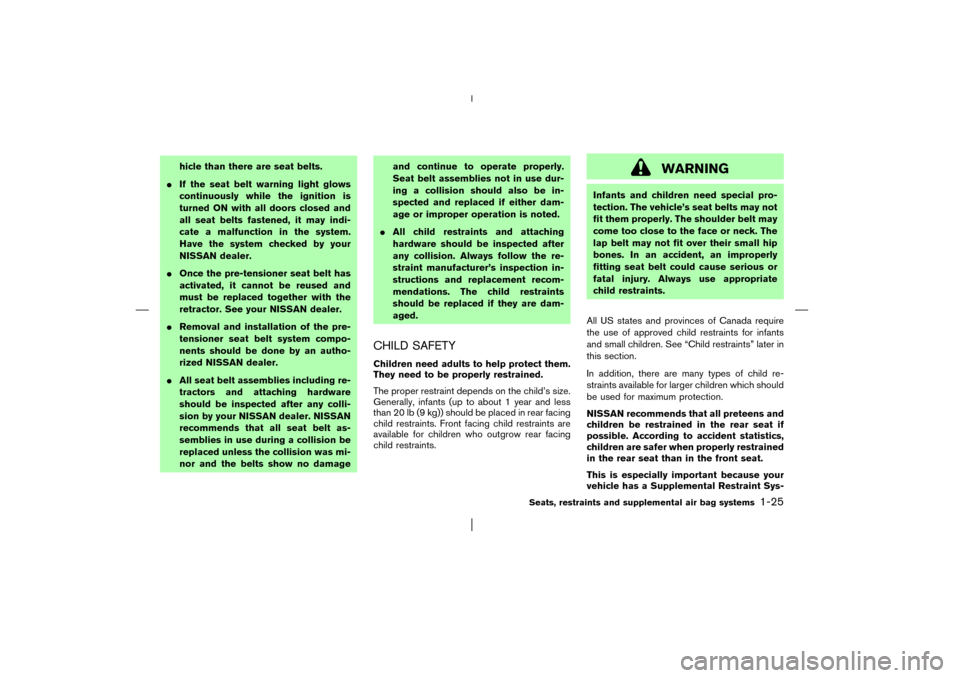
hicle than there are seat belts.
�If the seat belt warning light glows
continuously while the ignition is
turned ONwith all doors closed and
all seat belts fastened, it may indi-
cate a malfunction in the system.
Have the system checked by your
NISSAN dealer.
�Once the pre-tensioner seat belt has
activated, it cannot be reused and
must be replaced together with the
retractor. See your NISSAN dealer.
�Removal and installation of the pre-
tensioner seat belt system compo-
nents should be done by an autho-
rized NISSAN dealer.
�All seat belt assemblies including re-
tractors and attaching hardware
should be inspected after any colli-
sion by your NISSAN dealer. NISSAN
recommends that all seat belt as-
semblies in use during a collision be
replaced unless the collision was mi-
nor and the belts show no damageand continue to operate properly.
Seat belt assemblies not in use dur-
ing a collision should also be in-
spected and replaced if either dam-
age or improper operation is noted.
�All child restraints and attaching
hardware should be inspected after
any collision. Always follow the re-
straint manufacturer’s inspection in-
structions and replacement recom-
mendations. The child restraints
should be replaced if they are dam-
aged.
CHILD SAFETYChildren need adults to help protect them.
They need to be properly restrained.
The proper restraint depends on the child’s size.
Generally, infants (up to about 1 year and less
than 20 lb(9 kg)) should be placed in rear facing
child restraints. Front facing child restraints are
available for children who outgrow rear facing
child restraints.
WARNING
Infants and children need special pro-
tection. The vehicle’s seat belts may not
fit them properly. The shoulder belt may
come too close to the face or neck. The
lap belt may not fit over their small hip
bones. In an accident, an improperly
fitting seat belt could cause serious or
fatal injury. Always use appropriate
child restraints.
All US states and provinces of Canada require
the use of approved child restraints for infants
and small children. See “Child restraints” later in
this section.
In addition, there are many types of child re-
straints available for larger children which should
be used for maximum protection.
NISSAN recommends that all preteens and
children be restrained in the rear seat if
possible. According to accident statistics,
children are safer when properly restrained
in the rear seat than in the front seat.
This is especially important because your
vehicle has a Supplemental Restraint Sys-
Seats, restraints and supplemental air bag systems
1-25
�
03.1.28/R50-D/V5
�
Page 33 of 299
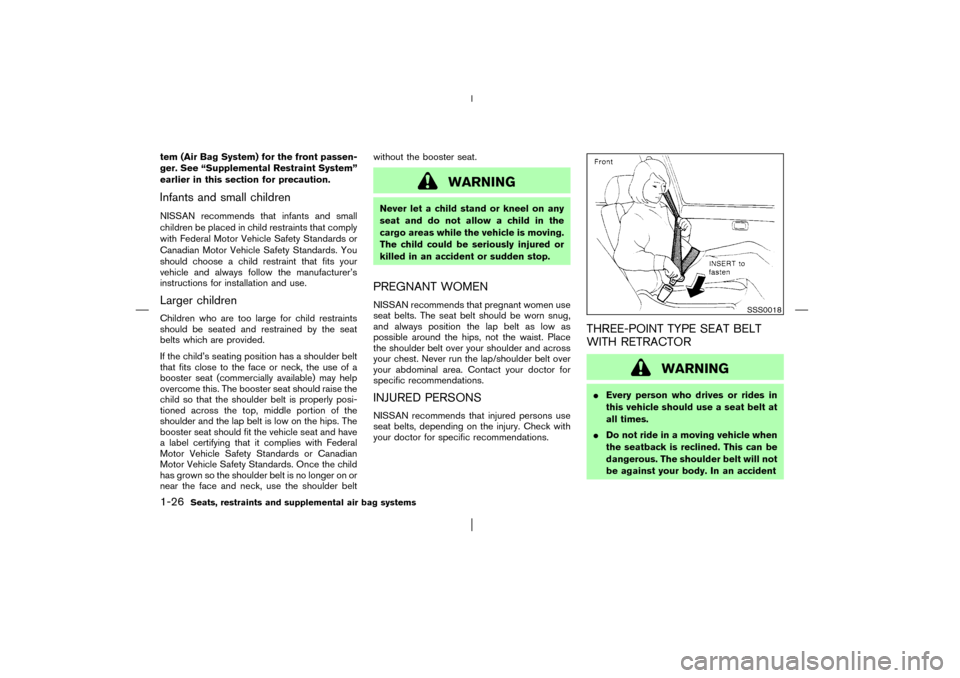
tem (Air Bag System) for the front passen-
ger. See “Supplemental Restraint System”
earlier in this section for precaution.Infants and small childrenNISSAN recommends that infants and small
children be placed in child restraints that comply
with Federal Motor Vehicle Safety Standards or
Canadian Motor Vehicle Safety Standards. You
should choose a child restraint that fits your
vehicle and always follow the manufacturer’s
instructions for installation and use.Larger childrenChildren who are too large for child restraints
should be seated and restrained by the seat
belts which are provided.
If the child’s seating position has a shoulder belt
that fits close to the face or neck, the use of a
booster seat (commercially available) may help
overcome this. The booster seat should raise the
child so that the shoulder belt is properly posi-
tioned across the top, middle portion of the
shoulder and the lap belt is low on the hips. The
booster seat should fit the vehicle seat and have
a label certifying that it complies with Federal
Motor Vehicle Safety Standards or Canadian
Motor Vehicle Safety Standards. Once the child
has grown so the shoulder belt is no longer on or
near the face and neck, use the shoulder beltwithout the booster seat.
WARNING
Never let a child stand or kneel on any
seat and do not allow a child in the
cargo areas while the vehicle is moving.
The child could be seriously injured or
killed in an accident or sudden stop.PREGNANT WOMENNISSAN recommends that pregnant women use
seat belts. The seat belt should be worn snug,
and always position the lap belt as low as
possible around the hips, not the waist. Place
the shoulder belt over your shoulder and across
your chest. Never run the lap/shoulder belt over
your abdominal area. Contact your doctor for
specific recommendations.INJURED PERSONSNISSAN recommends that injured persons use
seat belts, depending on the injury. Check with
your doctor for specific recommendations.
THREE-POINT TYPE SEAT BELT
WITH RETRACTOR
WARNING
�Every person who drives or rides in
this vehicle should use a seat belt at
all times.
�Do not ride in a moving vehicle when
the seatback is reclined. This can be
dangerous. The shoulder belt will not
be against your body. In an accident
SSS0018
1-26
Seats, restraints and supplemental air bag systems
�
03.1.28/R50-D/V5
�
Page 34 of 299
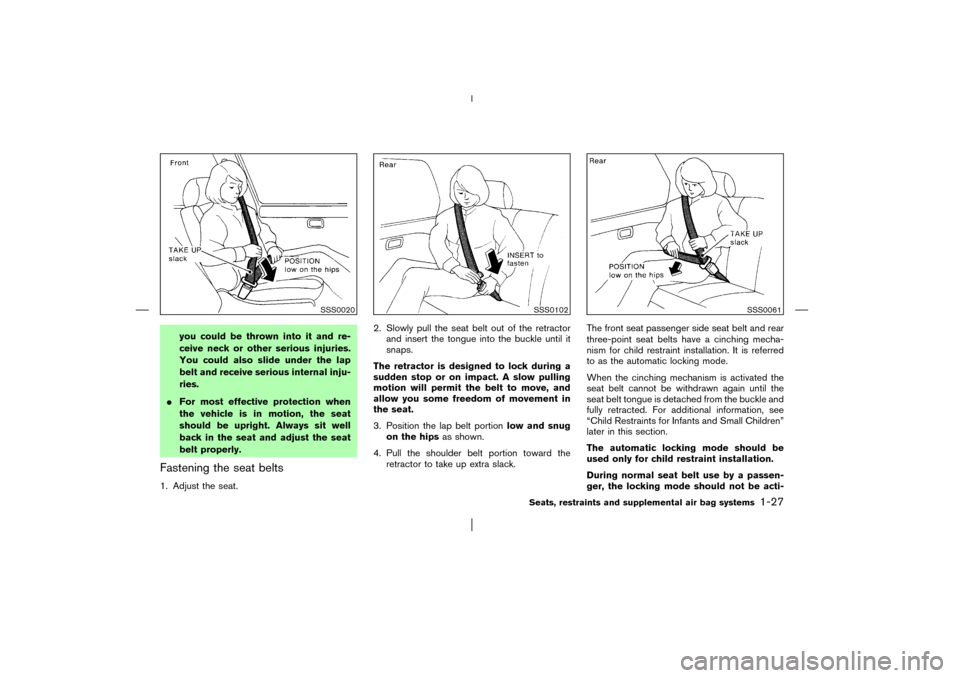
you could be thrown into it and re-
ceive neck or other serious injuries.
You could also slide under the lap
belt and receive serious internal inju-
ries.
�For most effective protection when
the vehicle is in motion, the seat
should be upright. Always sit well
back in the seat and adjust the seat
belt properly.
Fastening the seat belts1. Adjust the seat.2. Slowly pull the seat belt out of the retractor
and insert the tongue into the buckle until it
snaps.
The retractor is designed to lock during a
sudden stop or on impact. A slow pulling
motion will permit the belt to move, and
allow you some freedom of movement in
the seat.
3. Position the lap belt portionlow and snug
on the hipsas shown.
4. Pull the shoulder belt portion toward the
retractor to take up extra slack.The front seat passenger side seat belt and rear
three-point seat belts have a cinching mecha-
nism for child restraint installation. It is referred
to as the automatic locking mode.
When the cinching mechanism is activated the
seat belt cannot be withdrawn again until the
seat belt tongue is detached from the buckle and
fully retracted. For additional information, see
“Child Restraints for Infants and Small Children”
later in this section.
The automatic locking mode should be
used only for child restraint installation.
During normal seat belt use by a passen-
ger, the locking mode should not be acti-
SSS0020
SSS0102
SSS0061
Seats, restraints and supplemental air bag systems
1-27
�
03.1.28/R50-D/V5
�
Page 35 of 299
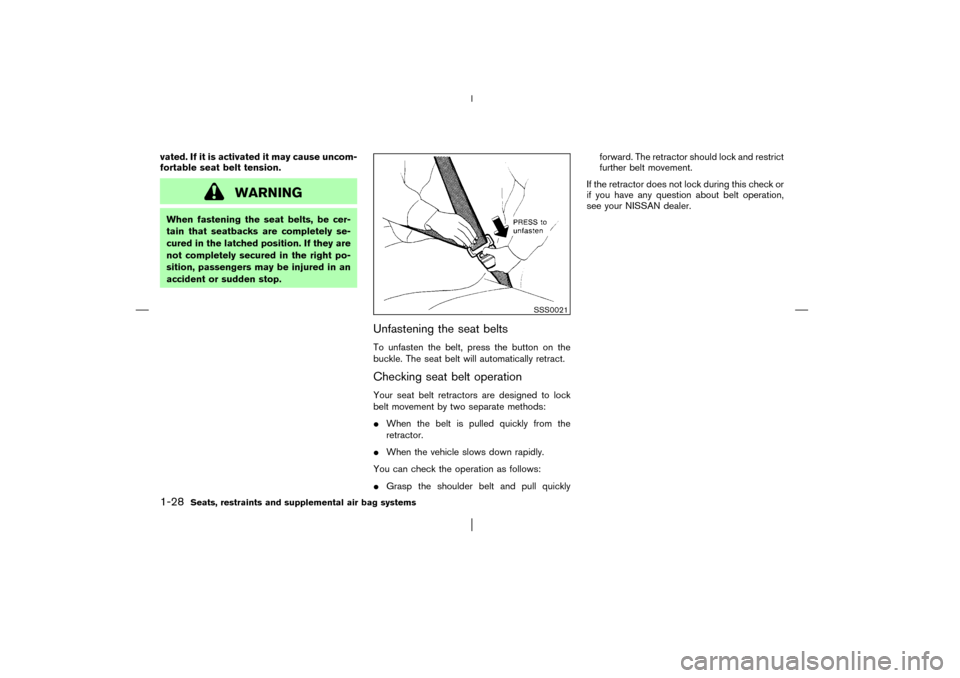
vated. If it is activated it may cause uncom-
fortable seat belt tension.
WARNING
When fastening the seat belts, be cer-
tain that seatbacks are completely se-
cured in the latched position. If they are
not completely secured in the right po-
sition, passengers may be injured in an
accident or sudden stop.
Unfastening the seat beltsTo unfasten the belt, press the button on the
buckle. The seat belt will automatically retract.Checking seat belt operationYour seat belt retractors are designed to lock
belt movement by two separate methods:
�When the belt is pulled quickly from the
retractor.
�When the vehicle slows down rapidly.
You can check the operation as follows:
�Grasp the shoulder belt and pull quicklyforward. The retractor should lock and restrict
further belt movement.
If the retractor does not lock during this check or
if you have any question about belt operation,
see your NISSAN dealer.
SSS0021
1-28
Seats, restraints and supplemental air bag systems
�
03.1.28/R50-D/V5
�
Page 36 of 299
Shoulder belt height adjustment (For
front seats)The shoulder belt anchor height should be ad-
justed to the position best suited for you (see
“Precautions on Seat Belt Usage” earlier in this
section). To adjust, push (Type A)/pull (Type B)
the release buttons, then move the shoulder belt
anchor to the desired position so that the belt
passes over the shoulder. Release the adjust-
ment buttons to lock the shoulder belt anchor
into position.
WARNING
�After adjustment, release the adjust-
ment button and try to move the
shoulder belt anchor up and down to
make sure it is securely fixed in po-
sition.
�The shoulder belt anchor height
should be adjusted to the position
best for you. Failure to do so may
reduce the effectiveness of the entirerestraint system and increase the
chance or severity of injury in an
accident.
PD1328MC
SPA0739BSeats, restraints and supplemental air bag systems
1-29
�
03.1.28/R50-D/V5
�
Page 37 of 299
Seat belt hookWhen the rear seat belt is not in use, hook it at
the belt hook.
TWO-POINT TYPE SEAT BELT
WITHOUT RETRACTOR (Center of
rear seat)
Selecting correct set of seat beltsThe center seat belt buckle and tongue are
identified by the CENTER mark. The center seat
belt tongue can be fastened only into the center
seat belt buckle.
Fastening the seat belts1. Insert the tongue into the buckle marked
CENTER until it snaps.
SPA0531
IC0589
SSS0103
1-30
Seats, restraints and supplemental air bag systems
�
03.1.28/R50-D/V5
�
Page 38 of 299
2. To lengthen, hold the tongue at a right angle
to the belt and pull on the belt.
To shorten, pull the free end of the belt away
from the tongue, then pull the belt clip to take
up the slack.
3. Position the lap beltlow and snug on the
hipsas shown.
Unfastening the seat beltsTo unfasten the belt, press the button on the
buckle.
SSS0024
SSS0025SSS0060
SSS0026
Seats, restraints and supplemental air bag systems
1-31
�
03.1.28/R50-D/V5
�